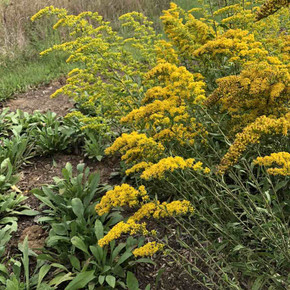

Please note your preferred ship date/week in the "Order Comments" section at checkout.
Otherwise, please allow 1-3 weeks to receive your order.
See the "Shipping" page under "Company Information" for our default ship dates based on hardiness zone.
We are unable to ship to any US Territories, AK, AZ, CA, CO, HI, ID, MT, NM, NV, OR, UT, WA, or WY
Tall, showy and later flowering than other goldenrods. Attracts bees and butterflies, including Monarchs.
Usually 4-5' tall x 2' wide clumps, reddish stems with dense plumes of golden flowers in August/September to October/November.
Somewhat slender looking clump perennial, that slowly spreads by rhizomes.
Full sun, half sun, adaptable to many soil types that stay medium, medium-dry to dry (not waterlogged soils) - including the worst clay, shallow, rocky soils. Tolerates poor and dry soils.
Attracts honeybees, bumblebees, ants, beetles, and the occasional moth or butterfly, including Monarchs. Host plant for caterpillars of many moths, several leafhoppers, lace bugs, plant bugs, and beetles. Eastern Goldfinch and the Greater Prairie Chicken will feed on the seeds, but it is not their preferable food source. Deer, rabbit and other bigger herbivores may sometimes nibble on it.
Native wildflower to eastern and central USA, see the USDA distribution map.
Hardy in zones 3 to 8.
Best in medium-sized to bigger naturalistic plantings, prairie style plantings,cottage gardens, pollinator gardens, butterfly gardens, Monarch gardens, for naturalization. Goes well with other taller native perennials like Asters, Allium cernuum, Coreopsis, Echinacea, Eryngium yuccifolium, Eupatorium hyssopifolium, Liatris, Helianthus, Monarda fistulosa, Penstemon digitalis, Rudbecia (R. subtomentosa, R. missouriensis), Scutellaria incana.
Pot size : square 3.5" x 4" deep perennial pot
Picture copyright : Leonardo Dasilva, Flickr
Tall, showy and later flowering than other goldenrods. Attracts bees and butterflies, including Monarchs.
Usually 4-5' tall x 2' wide clumps, reddish stems with dense plumes of golden flowers in August/September to October/November.
Somewhat slender looking clump perennial, that slowly spreads by rhizomes.
Full sun, half sun, adaptable to many soil types that stay medium, medium-dry to dry (not waterlogged soils) - including the worst clay, shallow, rocky soils. Tolerates poor and dry soils.
Attracts honeybees, bumblebees, ants, beetles, and the occasional moth or butterfly, including Monarchs. Host plant for caterpillars of many moths, several leafhoppers, lace bugs, plant bugs, and beetles. Eastern Goldfinch and the Greater Prairie Chicken will feed on the seeds, but it is not their preferable food source. Deer, rabbit and other bigger herbivores may sometimes nibble on it.
Native wildflower to eastern and central USA, see the USDA distribution map.
Hardy in zones 3 to 8.
Best in medium-sized to bigger naturalistic plantings, prairie style plantings,cottage gardens, pollinator gardens, butterfly gardens, Monarch gardens, for naturalization. Goes well with other taller native perennials like Asters, Allium cernuum, Coreopsis, Echinacea, Eryngium yuccifolium, Eupatorium hyssopifolium, Liatris, Helianthus, Monarda fistulosa, Penstemon digitalis, Rudbecia (R. subtomentosa, R. missouriensis), Scutellaria incana.
Pot size : square 3.5" x 4" deep perennial pot
Picture copyright : Leonardo Dasilva, Flickr
